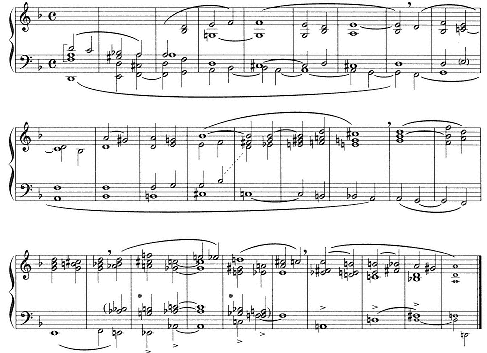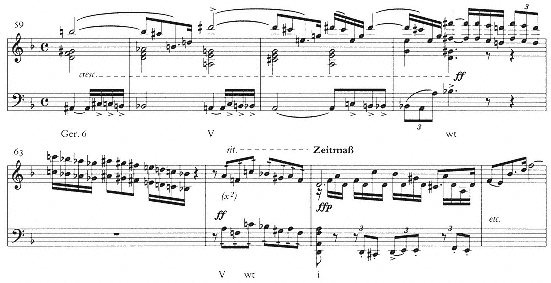The First Group: Harmonic Aspects
The thematic process of the first group rides on the surface of, and of course helps to generate, a chromatic harmony that is no less volatile. In his 1924 essay Berg presents a harmonic skeleton of the first ten measures of op. 7 in what he calls "chorale style" (ex. 8.7). He attempts to show that despite the profusion of chords that occurs within a short space, all represented in half notes in his example, "there is no single sonority, not even on the unaccented semiquavers

Example 8.7
Berg's "chorale" or harmonic reduction of the first theme of Schoenberg's First String Quartet, op. 7 (from Reich 1965, 197).
[eighth-notes] of these ten quartet bars, that cannot be immediately clear to any car educated in the of the last century" (Reich 1965, 198). As Christopher Wintle has shown, many of the verticalities in Berg's chorale can be explained along the lines of Schoenberg's own Theory of Harmony as chromatic alterations of certain basic chords (Wintle 1980, 52-55). And although, as Wintle also suggests. Berg's harmonies are sometimes dubious representations of what seems actually to be happening in the music, the chorale nevertheless offers a good starting point for an assessment of the local-level harmonic component of op. 7.
One of the striking things about the quartet-and this is readily apparent at the opening-is the avoidance of functional dominants on the small scale and the concomitant pervasiveness of vagrant harmonies. Berg's chorale displays a dominant-seventh harmony across (his) mm. 5-7; although the harmony is somewhat obscured by the motion of the voices, it is explicit in the first half of
m. 6 and throughout m. 7. In the actual piece, this dominant is even less apparent, and less structural. Although the A in the bass on the last eighth note of Schoenberg's m. 2 supports a


The harmonic goal of the first phrase is not the elusive dominant, but the



Across the A portion of the first group, Schoenberg's strategy seems to be to increase the level of dissonance and chromaticism progressively. The






The two-beat silence of m. 10 is shattering in effect: the musical discourse seems paralyzed or frozen by the disorienting harmonic-thematic spiral of theme y. The shock is then intensified, rather than dissipated, by the sequential repetition of y up a major third (and now fortissimo). The use of exact sequence (it is exact up to m. 12) is rare in Schoenberg's works after 1900, and is especially strik-

Example 8.8
First String Quartet, op. 7, alternation of whole-tone and seventh chords in mm. 8–10.

Example 8.9
Derivation and resolution of six-note whole-tone chord, from Schoenberg 1978, p. 392 (ex. 323).
ing in view of the negative opinion he often takes of it in his writings (see, for example, Schoenberg 1975, 129-31). Here the sequence seems specifically intended to exaggerate or prolong the disruption represented by y.
The combination of vagrant harmonies with fifth motion in the bass is reminiscent of certain works of 1899 and 1900, especially the song Jesus bettelt from op. 2 (see chapter 4) and Tove's"Du sendest mir einen Liebesblick"from Gurrelieder (see chapter 6). However, the whole-tone complex now plays a greater role, and does so in a way that has important implications for Schoenberg's compositional language in 1904-5. In op. 7, Schoenberg does not treat the whole-tone scale/chord as a purely symmetrical, rootless phenomenon. It is used less to weaken or loosen tonal implications than to intensify chromatic and vagrant harmonies. By resolving the whole-tone harmonies of mm. 8-9 emphatically up by fourth, as if they were dominant chords, Schoenberg seems to stress their functional aspect.
It is essential in this context to consider Schoenberg's discussion of whole tones in Theory of Harmony, where a chord containing all six notes of the whole-tone scale is derived from a dominant ninth, by "simultaneously raising and lowering the fifth"(Schoenberg 1978, 392). This ninth chord is then resolved by fifth, like a normal dominant, as in ex. 8.9. This resolution can be compared with those in theme y of op. 7, as shown in the first four chords of ex. 8.8. (In ex. 8.8 the

Example 8.10
First String Quartet, op. 7, transition to return of main theme (A").
whole-tone chords are represented with four, not six, notes; but, as suggested earlier, all six notes of the scale are in fact sounded in the music, where the effect and function are similar to Schoenberg's Theory of Harmony example.) This rootoriented view of even the most vagrant chords is fully characteristic of Schoenberg. As with any chord discussed in Theory of Harmony, he stresses the way in which the whole-tone sonorities are to be resolved and linked with other harmonies. In this respect he contrasts his own early compositions with those of his contemporaries:
Debussy uses this chord and scale more in the sense of impressionistic expressive devices, somewhat as a tone color (so does Strauss in Salome); but they entered my work more for the sake of their harmonic and melodic possibilities: the chords for the sake of their connection with other chords, the scale for the sake of its peculiar influence on the melody.
SCHOENBERG 1978, 393
The role of the whole-tone complex in op. 7 as intensification, rather than dissolution, of diatonic-chromatic relations is reinforced at the transition to A" in the first group (ex. 8.10). After the imitative statement of the main theme beginning on

chord like a German sixth on




The whole-tone scale breaks off abruptly in m. 63; the reappearance of the main theme in D minor is preceded in m. 64 by a transitional measure identical with the first measure of x2 (see ex. 8.10). Schoenberg's use of this thematic fragment as a transition is a masterstroke, for it serves genuinely to mediate between the preceding whole-tone scale and the subsequent D-minor return. Whole-tone elements are still present in the


Here we might do well to glance back at Berg's chorale (ex. 8.7), where the harmonic reduction of the second half of Schoenberg's m. 1 (the first half of m. 2 in the chorale) reveals a whole-tone chord of the French sixth type, with E in the bass. Berg's harmonic entity may not at first seem an accurate rendering of Schoenberg's music, since it freezes into a fictional simultaneity two pitches,


The whole process is a splendid example of the intimate, reciprocal relationship between the vertical and horizontal dimensions-between "harmony" and
[14] The relation of the whole-tone chord of m. 2 of Berg's chorale to that of m. 23 has been pointed out by Wintle (1980, 54).
"theme"—in the quartet. What begins as an apparently linear, thematic detail in the viola part of m. 1 becomes a harmonic element in the whole-tone sonorities of mm. 8-9, then evolves back into the former role with the whole-tone scale of mm. 62-63.